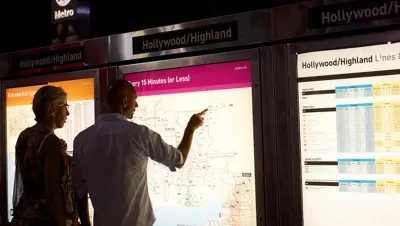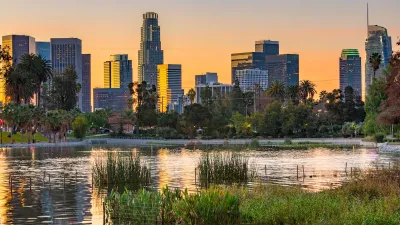If Los Angeles residents approve the $120 billion sales tax measure in November, focusing on walkable communities and offering fast, frequent transit service will be critical to its success.

"There is no place in the country better positioned to use transit to its advantage than Los Angeles County," opines Steven Higashide, a senior program analyst for TransitCenter, a New York foundation dedicated to improving urban mobility.
And should voters pass a county sales tax measure on November 8 by over two-thirds, $120 billion will be available to build-up public transit. But it's not just a matter of laying more track, constructing new stations, planning new bus lines and operating trains and running buses.
[I]f the goal of Los Angeles’ transit investments is to have buses and trains shape the region in the 21st century the way the automobile did in the 20th — building transit is not enough. For proof, look no further than Metro’s overall ridership, which so far is 5.5% lower in 2016 than in 2015 despite two new rail extensions.
Higashide repeats a theme made by Kevin Cashman, a Truthout researcher, in his recent critique of new transportation technologies, particularly in their ability to serve lower income populations.
For all the talk about using Uber, Lyft and bike share to bridge the 'first mile, last mile' gap to transit, it’s far more important to put bus and rail stops in places where people don’t have to walk a mile or more to reach them.
Transit needs to be in the middle of the action, not sent to the edge of town. New housing, offices, and retail should be concentrated near it.
Higashide points to a new TransitCenter report, "'Who’s On Board' [PDF], that gathered data from three focus groups and a survey of 3,000 people in 17 metro areas in the United States, [that] sheds light on how it can be done."
"It builds on the findings from TransitCenter’s first Who’s On Board report released in 2014 [and posted here] — the largest-ever attitudinal survey of transit riders—which showed that Americans from coast to coast think about and use public transit in remarkably similar and often unexpected ways," states the press release.
Higashide emphasizes the need to "reform land-use regulations to nurture inviting walking environments."
As another Times opinion piece noted, Los Angeles is a major global city whose zoning codes, parking requirements and development politics treat it like an enormous suburb. For transit to succeed, those laws and attitudes must change.
And the top priority for new transit expansion should be busy destinations that are already walkable. By making transit frequent and fast and building walkable neighborhoods around transit, Los Angeles can make it a practical choice for many more people.
FULL STORY: Opinion: Without more walkable cities, building new transit won't reverse Metro's ridership decline

Maui's Vacation Rental Debate Turns Ugly
Verbal attacks, misinformation campaigns and fistfights plague a high-stakes debate to convert thousands of vacation rentals into long-term housing.

Planetizen Federal Action Tracker
A weekly monitor of how Trump’s orders and actions are impacting planners and planning in America.

San Francisco Suspends Traffic Calming Amidst Record Deaths
Citing “a challenging fiscal landscape,” the city will cease the program on the heels of 42 traffic deaths, including 24 pedestrians.

Defunct Pittsburgh Power Plant to Become Residential Tower
A decommissioned steam heat plant will be redeveloped into almost 100 affordable housing units.

Trump Prompts Restructuring of Transportation Research Board in “Unprecedented Overreach”
The TRB has eliminated more than half of its committees including those focused on climate, equity, and cities.

Amtrak Rolls Out New Orleans to Alabama “Mardi Gras” Train
The new service will operate morning and evening departures between Mobile and New Orleans.
Urban Design for Planners 1: Software Tools
This six-course series explores essential urban design concepts using open source software and equips planners with the tools they need to participate fully in the urban design process.
Planning for Universal Design
Learn the tools for implementing Universal Design in planning regulations.
Heyer Gruel & Associates PA
JM Goldson LLC
Custer County Colorado
City of Camden Redevelopment Agency
City of Astoria
Transportation Research & Education Center (TREC) at Portland State University
Jefferson Parish Government
Camden Redevelopment Agency
City of Claremont





























